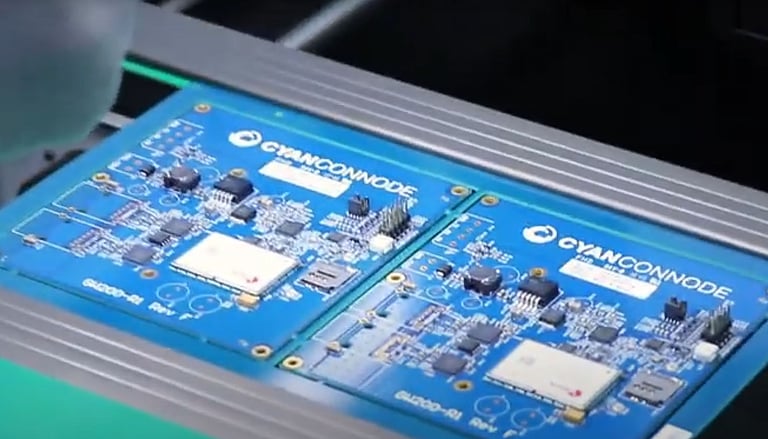CyanConnode Holdings plc (LON:CYAN) is the topic of conversation when Hardman and Co’s Technology Analyst Milan Radia caught up with DirectorsTalk for an exclusive interview.
Q1: We’ve spoken about CyanConnode before, but could you just remind us of the company’s primary products and solutions?
A1: As you mentioned, the company is one of the leading providers of what is known as narrowband RF mesh and what that means is that these technologies use quite low bandwidth radio frequencies to transmit data wirelessly and therefore consume very little bandwidth along the way and at quite low cost. The mesh approach means that there are multiple connections for every single device in a network so if one of the roots to a device suffers a problem and goes down, the device will remain connected and can still transmit information. You can imagine in regions where maintenance may be an issue or where cellular connections are poor, for example in rural regions around the world, RF technologies become particularly valuable. The company’s platform, which is called Omnimesh, actually offers RF mesh and cellular as well as other technologies such as power line and so on and that contributes to the very high performance metrics that the company’s installations tend to deliver.
One of the areas is where its technology has proven to be particularly relevant, where it’s actually become established now as a global leader is smart metering, and that’s where very reliable connections are required in order to both draw data from the meter about usage and so on, and that obviously directly feeds into the billing systems, but also to send commands to the meter. For example, there may be prepaid meters where payments are not being made, and it would be appropriate to disconnect the service under the terms of the contract with the end user.
What we’re seeing right now is the current financial performance of the company is very much being driven by very large scale programmes to roll out smart meters and that’s particularly the case in Asia and Africa. Just to show that listeners understand, the company doesn’t actually manufacture the meters in these instances themselves, that’s done by very large entities such as Schneider Electric and so on, but rather it provides the intelligent modules that go into the meters and the various software and infrastructure platforms that go around that.
So that’s their activities and remit.
Q2: So, are the financial and operational benefits of smart meters proven?
A2: The short answer is very much so. Actually, we now have the data across many, many markets to confirm that these are very, very valuable elements of the distribution infrastructure. The benefits come in the form of multiple different strands, operational technical, financial, and these are aspects that are very carefully tracked and measured by the utilities, as you might imagine.
In the emerging economies, the problems are more acute around some of these infrastructure aspects and it’s very typical for there to be gap between the power generation capacity of the country and the demand that there is from both the consumer enterprise elements of that economy. So, you end up with big shortfalls in energy supply and that’s often compounded by inefficiencies and losses in the distribution infrastructure, and that sits in between the power generation and the end user and that actually is a major concern for governments because ultimately it proves to be an impediment to economic growth. You see the various impacts in economies where electricity supply just shuts down, load shedding happens and so on, and that’s not sustainable longer term and so you can see that this is the major driver, the big roll-outs that are happening in some of the regions that we mentioned earlier.
The types of improvements that the company’s smart meter platform helps to deliver are typically in the range of 15% to 25% ultimately, that translates into at least tens of millions of dollars per annum for a typical distribution utility. In India, for example, just within the first 12 months of some of these smart meter deployments, the improvement in the loss ratios that the company’s platform is held to deliver have been in the order of 8%-10%, and that’s just in a very short period of time and there’ll be more improvement thereafter.
So yes, very much proven now.
Q3: Now, silicon shortages have disrupted many supply chains, how is the company fairing on that front?
A3: Well, the proof of the pudding is really in uninterrupted supply of their modules and the data confirms that they have managed to achieve this at a time in many other industry sectors are floundering, and they’ve done this through a number of different initiatives.
I think they are very good at manage their supplier relationships, there’s a lot of dialogue and a lot of discussion around what the growing requirements that they will, or that they are seeing, over time. They’ve expanded production lines with existing suppliers, they’ve added new suppliers and they’ve been ordering well in advance, now that does require obviously some working capital investment in inventory of components and so on.
We saw in the last six months that contributed to the cash position at the end of the period but this is overall, a very positive set of management decisions, in our view, that have allowed them to maintain that supply chain integrity during this period.
Q4: India is a major focus for the company, how is the region progressing?
A4: After a lengthy gestation period, I think it’s fair to say, activity levels in India with respect to smart meters tend to be surging at the moment and we discussed this in our most recent report that you mentioned earlier that there are some 37 million meters tendering at the moment, with an expectation on the contract awards for most of these tenders will be made prior to the end of this calendar year. We also expect actually in the meantime, more tenders to be added to that tally as more distribution utilities get to that contracting phase.
So, I think it’s fair to say that the immense revenue opportunity, this region is now set to become reality for all participants in the supply chain. It’s taken a while but that’s to be expected given the complexities around contracting for a programme that aims to deliver 250 million meter replacements over a 5/6 year time span.
Q5: Will the Indian programme achieve its targets in your opinion?
A5: In the end, these targets will be met even if the tail end extends beyond the current target period of the 5 years or so, and that comes back to the economic imperative to do so over the longer term around these inefficiencies and inadequacies in the power generation quota versus demand.
Much of the current impetus in India is actually being driven by government initiatives to potentially force the distribution utilities – DISCOMS as they’re commonly known – to engage more intensively with the programme. There are now financial incentives and penalties associated with the progress that they’re making, they’re being analysed and ranked in terms of the financial and technical losses that they’re actually incurring in the improvements that are being delivered so there is an element of naming and shaming on one level.
That means that the DISCOMS that don’t roll out will be visibly left behind, when in the past, they were simply within that broad range of industry performance and this is really a function of the substantial and pretty quick benefits that are occurring from smart meter rollouts and the tangible impact on those loss ratios that we’ve mentioned.
Another key element is the funding of these rollouts. It’s widely understood that cash strapped distribution utilities aren’t well positioned to fund the upfront payments for meter hardware, software licenses, platform investments, the implementations and so on that are required. That’s a pretty hefty cash burden, and so the OPEX model is being introduced at a relatively brisk pace and some of the entities such as IntelliSmart and ESL are very strong, which are bodies responsible for some of these procurement initiatives on behalf of utilities and so on. They’re very much in favour of this OPEX type arrangement.
What that means is that third party funding can be brought to bear on these arrangements, it may be infrastructure funds for example, that decide to invest, and they will allow the utilities to rent this metering infrastructure for the first 8-10 years say, and then the platform would be handed over to them under the terms of the commercial agreements.
The funders will of course make an attractive return in the meantime, but you can see it’s a win-win, you get accelerated deployments, you ease that financial burden for utilities and their financial performance obviously improves as the losses come down and the end users also benefit as that kind of efficiency grows over time.
So yes, I think the targets will be met and the early signs are now very, very encouraging, given this accelerating pace.
Q6: Now, in your recent report, you talk about the EPCs becoming involved as prime contractors, can you tell us more about that?
A6: EPC stands for Engineering Procurement Construction management, and these EPCs are essentially large-scale prime contractors with big balance sheets and with the resources, global footprint, skills to take on complex projects and deliver all of the major elements within a specified timeframe. You can see that this type of capability is very well suited to the complexities of the Indian smart meter programme, which has got a lot of moving parts, a lot of suppliers, execution challenges into rural areas and very densely populated urban areas.
So, with the renewed momentum, the OPEX funding arrangements we talked about, and far more understanding actually amongst the decisionmakers as to who can deliver and who can’t, the service level agreements are becoming very stringent and vendors such as CyanConnode that have a proven ability to deliver 99.5% success rates, well ahead of a lot of their peers, that there’s recognition of that. The EPCs, as a result of all of this, are far more interested in committing resources to the market.
This is a positive development for, again, the likely pace of progress from here as the EPCs will take roles alongside the meter manufacturers and suppliers which will have opportunities to supply the EPCs amongst other players in the market.
Q7: Now that there’s tangible momentum in the Indian rollout, how should we think about the scale of the opportunity for CyanConnode?
A7: This is the million dollar and possibly even the billion dollar question, as I suggested in the report.
The tenders that are ongoing today, so around 37 million meters, represent only 15% of the total plan rollout of 250 million meters. Of course, we don’t know the precise terms of the contract that’ll signed, and there will be some volume discounts that get applied along the way, but using historical implied revenue parameters, we estimate the market for the company, just for this current round of 37 million meters and assuming that they win 15%, which is, I don’t think a demanding percentage win rate, given their proven efficacy from existing deployments, we would expect the total revenue from this round alone to be well over $100 million.
Now, that’ll be spread over 7-10 years, but that’s only 15% of the total programme, if you think about that, and you’re basically multiplying by about 6-7 times to get to the overall programme value so we’re saying, $700 million plus comfortably would be the company’s revenue opportunity, just from winning 15% so less than 1 in 6 of the meter deployments that will be made, again, over 7-10 years.
One thing I would say is that a meaningful slice of that revenue be upfront to the company to cover the hardware element and there seems to be acknowledgement that that would be the appropriate contracting mechanism, whereas the software and services would be recognised on a deferred basis.
So, that’s interesting, isn’t it? You’ve got a revenue opportunity of many, many hundreds of millions of dollars and that should be viewed in the context of the current size of the company measured by market cap etc .
So, yes, it’s a very interesting question, and the pivotal question for anyone looking at this company.








































